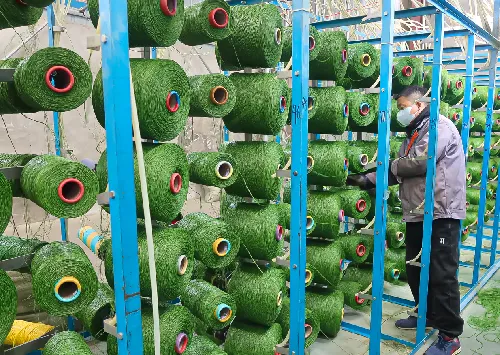
- Afrikaans
- Arabic
- Belarusian
- Bengali
- Czech
- Danish
- Dutch
- English
- Esperanto
- Estonian
- Finnish
- French
- German
- Greek
- Hindi
- Hungarian
- Icelandic
- Indonesian
- irish
- Italian
- Japanese
- kazakh
- Rwandese
- Korean
- Kyrgyz
- Lao
- Latin
- Latvian
- Malay
- Mongolian
- Myanmar
- Norwegian
- Persian
- Polish
- Portuguese
- Romanian
- Russian
- Serbian
- Spanish
- Swedish
- Tagalog
- Tajik
- Thai
- Turkish
- Turkmen
- Ukrainian
- Urdu
- Uighur
- Uzbek
- Vietnamese
laying artificial lawn
Oct . 20, 2024 16:17 Back to list
Laying Artificial Lawn A Comprehensive Guide
In recent years, artificial lawns have gained immense popularity among homeowners and landscapers seeking a low-maintenance, aesthetically appealing alternative to natural grass. With advancements in technology, modern synthetic turf mimics the look and feel of real grass, making it an attractive option for gardens, playgrounds, and sports fields. This article will guide you through the process of laying artificial lawn, ensuring a successful installation that enhances your outdoor space.
Understanding the Benefits of Artificial Lawn
Before diving into the installation process, it’s essential to understand why artificial lawns have become a preferred choice for many. One of the primary advantages is the significant reduction in water usage. In regions where water is scarce, opting for synthetic turf can drastically lower utility bills while contributing to environmental conservation. Additionally, artificial lawns eliminate the need for mowing, fertilizing, and pest control, thereby saving time and money.
Moreover, synthetic turf remains vibrant all year round, regardless of weather conditions. With proper installation, it can withstand heavy foot traffic, making it suitable for various applications, from residential gardens to commercial landscapes. This durability ensures that your outdoor area remains attractive and functional for years to come.
Preparing for Installation
The first step in laying an artificial lawn is thorough preparation of the installation area. Begin by clearing the designated space of any existing grass, weeds, and debris. It's crucial to have a clean, flat surface since any imperfections can affect the final appearance and function of the lawn.
Next, ensure proper drainage by excavating to a depth of at least 3–4 inches. After excavation, consider adding a layer of crushed stone or gravel to promote drainage. Compact this base material using a roller or compactor to create a stable and level foundation. A well-prepared base is crucial for preventing water pooling and prolonging the life of your artificial lawn.
Laying the Artificial Lawn
laying artificial lawn

Once the base is ready, it’s time to lay the artificial lawn. Start by unrolling the synthetic turf in the area you have prepared. If you are using multiple rolls, ensure that the blades of grass on adjacent sections are facing the same direction for a seamless appearance. The seams between the pieces should be carefully aligned to minimize visibility.
After positioning the turf, use a utility knife to trim the edges as needed. It’s essential to leave a slight overhang at the edges to ensure complete coverage. Once trimmed, secure the edges using landscape staples or adhesive, depending on your preference and the specifications of your product.
Infilling and Grooming
To achieve a more natural appearance, many artificial lawns require an infill. This process involves spreading silica sand or rubber granules evenly over the surface. The infill serves several purposes it helps weigh down the turf, gives the lawn a fuller look, and aids in grass blade recovery after foot traffic. Utilize a broom or a power broom to help spread the infill evenly across the lawn.
After infilling, groom the grass blades by using the broom to lift them upright. This step not only enhances the appearance of the lawn but also ensures that the infill settles properly.
Maintenance Considerations
Although artificial turf is low maintenance, it still requires some care to keep it looking its best. Regularly removing debris such as leaves or branches will prevent mold and ensure proper drainage. Occasionally, rinse the turf with water to remove dust and allergens, and check for any signs of wear or damage.
Conclusion
Laying an artificial lawn can significantly improve the appeal and functionality of your outdoor space. With proper preparation and installation techniques, you can achieve a beautiful and durable lawn that offers numerous benefits. Whether creating a relaxing garden, a safe play area for children, or a vibrant space for entertaining, synthetic turf is a smart choice that combines aesthetic value with practicality. Embrace the many advantages of artificial lawns and enjoy a lush, green landscape all year round without the hassles of maintenance associated with natural grass.
-
The Benefits of Artificial Turf for Indoors
NewsJul.15,2025
-
How Artificial Grass Suppliers Ensure Quality Products
NewsJul.15,2025
-
Artificial Grass and Pets: A Space for Relaxation
NewsJul.08,2025
-
Balcony & Outdoor Decoration with Artificial Grass
NewsJul.08,2025
-
Best Indoor Artificial Grass for Home
NewsJul.07,2025
-
Best Pet Turf for Dogs: Safe & Durable Artificial Grass Options
NewsJul.07,2025
Products categories









